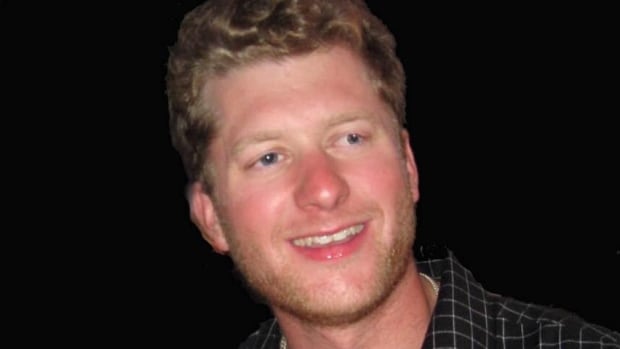Pathologist doesn’t believe Myles Gray ‘would’ve died when he did’ if not for police restraint, inquest hears
The forensic pathologist who autopsied Myles Gray’s body after he was beaten by Vancouver police in 2015 said he determined a “perfect storm” of factors led to his death, primarily extreme stress on his heart and lungs as well as officers having forcefully restrained him on the ground.
Dr. Matthew Orde told a coroner’s inquest on Thursday he designated Gray’s cause of death as “cardio-pulmonary arrest” complicated by police officers who caused multiple blunt-force injuries, compressed his neck, pepper-sprayed him, handcuffed him behind his back and forcibly held him on his stomach.
“I don’t think he would’ve died when he did, had it not been for the police interaction on that day,” said Orde, testifying as an expert witness.
“The fact Gray was forcibly held in a prone position would’ve likely contributed to his demise.”
Orde said witness accounts led him to believe Gray, 33, was potentially experiencing an “acute behavioural disturbance” because he was acting strangely the day he died but rejected excited delirium as a cause of death.
“I’m not persuaded there’s any good evidence to suggest excited delirium syndrome can bring about death,” he said, referring to a contentious term describing a state of agitation and often cited in police-related deaths.
Orde’s testimony comes on the penultimate day of a coroner’s inquest examining Gray’s death in a Burnaby, B.C., backyard in August 2015. The inquiry can’t make findings of legal responsibility, but the jury is tasked with making recommendations to prevent similar deaths.
Melissa Gray, Myles Gray’s sister, said the pathologist’s testimony provided her family with more clarity around how Gray died.
“I want the world to know the truth came out today,” she said, speaking outside the coroner’s offices Thursday.
Sitting in the gallery Thursday, the family saw autopsy photos of Gray’s face and head as their lawyer, Ian Donaldson, held them during his questioning of Orde. Melissa Gray and her mother, Margie, said they were angered to learn the photos would not be submitted as exhibits for the jury to see.
“We saw a glimpse of those photos, and he is unrecognizable — unrecognizable. It’s intensely traumatizing, and they’re standing up because they do not want these photos even shown to the jury,” said Margie Gray, referring to lawyers for the police department.
“Now I wonder why that is?”
Orde told the jury Gray’s heart and lungs would’ve been working overtime as police held him to the ground with his hands handcuffed behind his back. The pathologist said data shows “quite clearly” that people who are forcibly restrained in that “prone” position are at greater risk of dying.
He said a handcuff was still around Gray’s wrist at the time of his autopsy three days after he died.
The inquest has heard from police officers, firefighters, paramedics, 911 callers and a toxicologist who spoke about Gray. Police, who were the only witnesses to the man’s death, have said he was erratic, unusually strong and resisting arrest even after officers exerted force.
Other first responders contradicted police testimony that Gray wasn’t visibly injured by saying he was bruised and bloodied when they arrived. One advanced life-support paramedic said he did not realize Gray was a white man because of the extensive discolouration of his skin.
On Wednesday, a toxicologist with the B.C. Centre for Disease Control said a natural stimulant cited by Crown prosecutors as a potential cause of Gray’s death can’t be definitively confirmed as having actually been in his system at all.
Aaron Shapiro said an initial toxicology screen found Gray’s blood might have contained mitragynine, also known as kratom but said he changed the final report before testifying after examining a second analysis that showed there was only a small quantity of the drug present, if any.
Police officers involved in Gray’s death told the inquest they perceived him as either intoxicated, high or using steroids on account of his behaviour, strength and unresponsiveness to pain as he was beaten.
He said an initial toxicology screen found no traces of alcohol, opioids or hallucinogens in Gray’s blood. It did find the potential for tetrahydrocannabinol, or THC, but Shapiro said the second confirmation test was never done.
THC is the primary psychoactive substance found in marijuana and can stay in the body for weeks. Shapiro said Wednesday the drug “would not lead to” the behaviour police described.
Gray’s sister and physician previously told the inquest he had been diagnosed with bipolar disorder as a teenager around 1999 but was believed to have been stable since.

All of the officers who testified during the inquest have used similar language to describe Gray’s “threatening” behaviour toward police during the struggle to restrain him.
They said Gray continued fighting after being pepper-sprayed, punched, kneed, kicked, struck with batons and placed in a chokehold. Several said he appeared as though he was on testosterone.
Shapiro said the lab screened for several anabolic steroids but did not find any such substances, though he noted testing of the day wasn’t capable of detecting every steroid on the market.

Gray had been in Vancouver making a delivery to a florist’s supply shop as part of his Sechelt, B.C.-based business operations. Police were initially called after residents reported an agitated man had sprayed a woman with a garden hose.
Four police officers and a paramedic have told the inquest they believed Gray was experiencing “excited delirium.”


